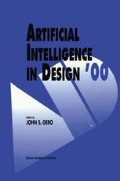Abstract
This paper argues that shape grammars provide a unified foundation for engineering expert systems. Shape grammars maintain the generative and analytical ability of traditional production systems. However, the parametric nature of shape grammars, their ability to deal with physical form rather than abstract elements and their ability to recognize emergent shapes give them significant advantages over traditional production systems for geometry based engineering design.
Access this chapter
Tax calculation will be finalised at checkout
Purchases are for personal use only
Preview
Unable to display preview. Download preview PDF.
References
Agarwal, M., and Cagan, J.: 1998, A blend of different tastes: The language of coffee makers, Environment and Planning B: Planning and Design, 25(2), 205–226.
Agarwal, M., Cagan, J., and Stiny, G.: 1999a, A micro language: Generating MEMS resonators using a coupled form-function shape grammar, accepted: Environment and Planning B: Planning and Design.
Agarwal, M., Cagan, J. and Constantine, G. C: 1999b Influencing generative design through continuous evaluation: associating costs with the coffeemaker shape grammar, Artificial Intelligence in Engineering, Design, Analysis and Manufacturing, 13, 253–275.
Brown, K. N. and Cagan, J.: 1997, Optimized process planning by generative simulated annealing, Artificial Intelligence in Engineering Design, Analysis and Manufacturing, 11, 219–235.
Brown, D. C., and Chandrasekaran B.: 1986, Knowledge and control for a mechanical design expert system, Computer, July, pp. 92–100.
Cagan, J., and Mitchell, W. J.: 1993, Optimally directed shape generation by shape annealing, Environment and Planning B, 20, 5–12.
Chomsky, N.: 1957, Syntactic Structures, Mouton, The Hague.
Coyne, R. D. and Newton, S.: 1989, A tutorial on neural networks and expert systems for design, Proceedings of the Australasian Conference on Expert Systems in Engineering, Architecture and Construction, pp. 321-337.
Dixon, J. R., Howe, A. H., Cohen, P. R. and Simmons, M. K.: 1987, DOMINIC I: Progress towards domain independence in design by iterative design, Engineering with Computers, 2, 137–145.
Fitzhorn, P. A.: 1990, Formal graph languages of shape, (AI EDAM) Artificial Intelligence for Engineering Design, Analysis and Manufacturing, 4(3), 151–164.
Koning, H., and Eizenberg J.: 1981, The language of the prairie: Frank Lloyd Wright’s prairie houses, Environment and Planning B, 8, 295–323.
Liebowitz, J.: 1998, The Handbook of Applied Expert Systems, CRC Press.
Marcus, S., Stout, J. and McDermott, J.: 1998, VT: An expert elevator designer that uses knowledge based backtracking, AI Magazine, 9(1), 95–112.
McDermott, J.: 1981, R1: The formative years, AI Magazine, 2(2), 21–29.
Reddy, G., and Cagan, J.: 1995, An improved shape annealing algorithm for truss topology generation, ASME Journal of Mechanical Design, 117(2(A)), 315–321.
Shea, K., and Cagan, J.: 1997, Innovative dome design: Applying geodesic patterns with shape annealing, Artificial Intelligence in Engineering Design, Analysis and Manufacturing, 11, 379–394.
Stiny, G.: 1980, Introduction to shape and shape grammars, Environment and Planning B, 7, 343–351.
Stiny, G.: 1992, Weights, Environment and Planning B: Planning and Design, 19, 413–430.
Stiny, G.: 1996, Useless rules, Environment and Planning B: Planning and Design, 23, 235–237.
Stiny, G. and Gips, J.: 1980, Production systems and grammars: A uniform characterization, Environment and Planning B, 7, 399–408
Stiny, G., and Mitchell, W. J.: 1978, The Palladian grammar, Environment and Planning B, 5, 5–18.
Author information
Authors and Affiliations
Editor information
Editors and Affiliations
Rights and permissions
Copyright information
© 2000 Springer Science+Business Media Dordrecht
About this chapter
Cite this chapter
Agarwal, M., Cagan, J. (2000). Shape Grammar-Based Expert Systems for Engineering Design. In: Gero, J.S. (eds) Artificial Intelligence in Design ’00. Springer, Dordrecht. https://doi.org/10.1007/978-94-011-4154-3_10
Download citation
DOI: https://doi.org/10.1007/978-94-011-4154-3_10
Publisher Name: Springer, Dordrecht
Print ISBN: 978-94-010-5811-7
Online ISBN: 978-94-011-4154-3
eBook Packages: Springer Book Archive

